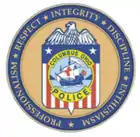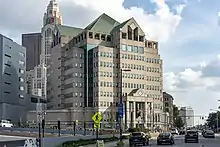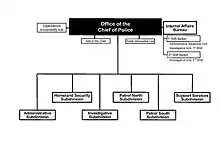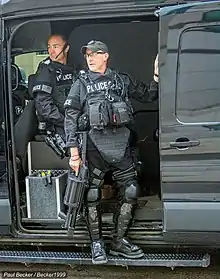Columbus Division of Police
The Columbus Division of Police is the main policing unit for the city of Columbus, Ohio, in the United States. It is the largest police department in the state of Ohio, and among the twenty-five largest in the United States.[2][3] It is composed of twenty precincts, and the interim chief of police is Mike Woods. Special units of the Columbus Division of Police includes a Helicopter Unit, Canine Unit, Mounted Unit, Community Response Teams, Marine Park Unit, and Special Weapons and Tactics Team (SWAT).[4]
| Columbus Division of Police | |
|---|---|
 | |
 | |
 | |
| Common name | Columbus Police |
| Abbreviation | CPD |
| Motto | Professionalism, Respect, Integrity, Discipline, Enthusiasm |
| Agency overview | |
| Formed | 1816 |
| Employees | 2,255 (2020) |
| Annual budget | $360 million (2020)[1] |
| Jurisdictional structure | |
| Operations jurisdiction | Columbus, Ohio, USA |
| Size | 223.11 sq mi (577.9 km2) (2013) |
| Population | 895,877 (2018) |
| General nature | |
| Operational structure | |
| Headquarters | Columbus, Ohio |
| Police Officers | 1,870 (2020) |
| Civilians | 385 (2020) |
| Agency executive |
|
| Subdivisions | List
|
| Facilities | |
| Precincts | 20 |
| Motorcycles | 31 |
| Police Boats | 5 |
| Helicopters | 5 |
| Canines | 10 |
| Horses | 10 |
| Website | |
| Columbus Police Website | |
As of June 2020 the Division was staffed with roughly 1,885 sworn police officers and 325+ civilian staff. In comparison in 2016, the staffing was reported as 1,848 sworn officers and 416 civilian staff. The estimated total budget in 2016 was $310,139,284.[5]
Training
The James G. Jackson Police Training Academy was opened in 2004 and is located west of the downtown. Since its opening it has become a reginal training center for Ohio Law Enforcement. Basic academy classes require recruits to train for six months and pass the Ohio Peace Officers Training Commission (OPTC) standardize testing. All sworn officers are required to attend annual training that includes state mandated training, legal updates, firearms proficiently and attend Defensive Tactics refresher training. Local police departments also attend training at the academy with classes ranging from investigative to seminars on specialized subjects. The training staff consists of 30+ instructors divided into Basic and Advance Training Sections. Firearms training is conducted off-site at the location of the previous police academy.
Structure

The Columbus Division of Police has a total of six subdivisions. The subdivisions include Patrol Operations, Public Accountability, Criminal Investigations, Support Services, Community Services and Special Operations. Each subdivision is commanded by a deputy chief. As the Division has grown in size the number of subdivisions has increased. As of 2015, the Division had 460 marked patrol vehicles, 410 unmarked vehicles, 31 motorcycles, 154 bicycles, five boats, ten horses, ten police dogs, and five helicopters.[5]
Rank Structure
Current rankings are as follows: (Generally as of 2020)
| Chief of police | 1 | |
| Deputy Chief | 6 | |
| Commander | 18 | |
| Lieutenant | 58 | |
| Sergeant | 220 | |
| Police Officer | 1,580 | |

_33.jpg.webp)
Patrol Operations Subdivision
This Subdivision's Deputy Chief is Michael Woods. The Subdivision includes Patrol Zones 1,2,3,4 and 5. This subdivision includes all geography areas of the City and is further divided into twenty precincts. This subdivision is the largest by staffing within the Division. Uniformed Patrol Officers handle dispatched calls for service from residents and patrol the incorporated area. [6]
Public Accountability Subdivision
The Public Accountability Subdivision includes the Fiscal Management Bureau, Human Resources Bureau, Professional Standards Bureau, and Internal Affairs Bureau. Background Investigations for police recruits falls within this subdivision as well. [7]
Criminal Investigations Subdivision
This Subdivision's Deputy Chief is Timothy Becker. The Criminal Investigations Subdivision includes Major Crimes Bureau, Drug Crimes Bureau, and Special Victims Bureau. Homicide, Robbery, Gun Crimes, Drug Task Forces, Sexual Assault and Missing Persons are only some of the investigative units assigned under this subdivision. [8]
Support Services Subdivision
The Support Services Subdivision includes the following bureau's: Forensics, Records Management, Support Operations and Wellness. The Crime Lab, Records, Identification, Evidence Room, Impound Lot and Court Liaison units report to this deputy chief. [9]
Community Services Subdivision
The Community Services Subdivision houses the Community Response Bureau, Property Crimes Bureau and the Training Bureau. The Recruiting Unit, Community Liaison, General Detectives and the Academy Training staff all work under this subdivision.
Special Operations Subdivision
This Subdivision's Deputy Chief is Kenneth Kuebler. The Special Operations Subdivision includes the Communications Bureau, Special Services Bureau, and Traffic Bureau. The 911 Call Center, SWAT, Homeland Security and Special Events are managed in this subdivision[10] The City of Columbus announced that in 2021 the Communications Bureau would be transferred to the Public Safety Department. It will be led by a civilian supervisor and will provided services to the Fire and Police Divisions.
Chiefs of Police
The department's current chief of police is Thomas Quinlan who was appointed in 2019. Previous Chefs of Police include Chief Kimberley Jacobs - appointed 2012, (Interim) Chief Gammill - appointed 2012, Chief Distelzweig - appointed 2009, Chief James G. Jackson - appointed 1990, Chief D. Joseph - appointed 1983, Chief Burden - appointed 1972 and Chief W. Joseph appointed 1970. [11]
Marked vehicles
The Columbus Police standard marked patrol fleet consists largely of Ford Police Interceptor Utility,[12] Ford Police Interceptor,[13] and Ford Crown Victoria Police Interceptor models. The Ford E-350 and Ford Transit 250 are used to transport prisoners.
Marked vehicles can be identified by the numbered license plates. Two, three and four digit plates show the precinct number followed by the car number. So a plate bearing the number 55 is assigned to Precinct-5 and is car-5; where plate 190 is precinct-19 car-0. Vehicles outside the standard precinct structure, i.e. Freeway Patrol, and Motorcycle Patrol also follow this pattern, where their unit is given a unique "precinct" number. For example, Freeway Patrol cruisers start with 6. Community Liaison cruisers begin with 3. Marked vehicles with a four digit starting in "9" are "mid-watch" assignments with the same pattern for their respective precinct.
The letter "R" as a prefix to this system denotes a "relief car". Plate R-106 is used because the 10th precinct has a regular vehicle in maintenance or repair. The letters "S" and "L" stand for Sergeant and Lieutenant, and denote that vehicle assigned to that ranked officer assigned to the following numbered precinct or zone: S-12 is the Sergeant for Precinct-12 and L-1 is the Lieutenant for Zone-1. The letter "T" Denotes a "Training" vehicle assigned to the police academy. The letter "X" stands for "eXtra"; X-Cars are kept at the city fleet management facility and are available to officers for special duty. "R" and "X" cars are, usually, re-numbered "retired" patrol cruisers in good condition.
In previous years, CPD utilized the Chevrolet Impala, Chevrolet Tahoe, Chevrolet Caprice, Plymouth Gran Fury, and Ford LTD II as cruisers.[14]
Special Duty
Some police duties that are required by law or requested by the general public fall outside the realm of normal, everyday procedures. For example, Ohio law requires that only a law enforcement officer may close a public road, or a lane thereof, without establishing a legal, marked detour (for road closure), or using concrete barriers (for lane restrictions only). In the event of a short-term construction project, a law enforcement officer must be on site to legally close the area to traffic.[15]
Columbus Police are permitted to work "Special Duty" assignments, upon approval, while off duty. Special Duty assignments can include anything from closing highway lanes for short-term road construction, to directing traffic for events, escorting a funeral procession, or providing security for private businesses, such as banks or stores. Most special duty assignments are paid for by the organization requesting the officer. However, while on Special Duty, the officer works for the City of Columbus, regardless the posting, and can be called upon by on-duty personnel if needed.
Funding and overruns
The City of Columbus plans to spend $359 million on the department in 2020, including $332 million in personnel costs. This is contrasted by Cleveland at $218 million and Cincinnati at $151 million.[16] The city has spent about $300 million each year on the department. 2019 costs include $345 million for police, $266 million for fire, $40 million in development (planning, housing, administration, etc.) $24 million for the health department, $5 million for the neighborhoods department, $40 million for recreation and parks, $31 million for trash collection, and about $31 million on its municipal court.[17]
The department was criticized in 2010 for funding its officers to become taxpayer-funded millionaires. Upper-management officers, through the Deferred Retirement Option Plan (DROP), can retire at age 48 and receive 60-72 percent of their salary as a pension, and still have the option of working and earning a salary. The program allows these officers to receive lump sums of $1 million, with annual raises of 3 percent. Individual officers living to age 78 are eligible to collect $3.25 million from taxpayers through the program, with only $74,000 contributed from the officer. The DROP program is kept largely secret, with no official estimate of the overall expense.[18]
The Deferred Retirement Option Plan (DROP) was first requested by the Ohio Chief of Police and Ohio Fire Chiefs as a means to retain trained and seasoned employees. This optional benefit allows members who are eligible to retire to stay on duty serving their communities for up to eight years. Although different opinions exist concerning the DROP program it has allowed for retention of firefights and police officers that would have otherwise not been replaced due to budgetary concerns. [19] The program is administered by the Police & Fire Retirement Fund (OP&F). This fund was created in 1965 in an effort to consolidate 454 local public safety pension funds across Ohio. Currently OP&F serves approximately 27,000 active members and more than 30,000 retirees and their beneficiaries. [20] The fund receives monies from active member and their employers and distributes benefits to retirees and other beneficiaries and directed by the Board of Directors.
Misconduct
Several instances of misconduct by Columbus police officers have been reported over the years.
In January 1998, at least seven Division officers were arrested for aiding local drug rings.[21]
On 21st October 1999, the Civil Rights Division on the US Department of Justice found that "CPD officers are engaged in a pattern or practice of using excessive force, making false arrests and lodging false charges, and conducting improper searches and seizures in violation of the Fourth and Fourteenth Amendments to the Constitution."[22] An effort to have the Division sign a Consent Decree failed. Since that time many of the DOJ mandates have been implemented through policy changes and additional training.
The Public Safety Director sometimes rehires police officers it has fired for misconduct. In 2016, Officer Eric Moore was fired for overtime fraud. He was later rehired. In that same year Office Chad Knode was fired for profiting off the sale of city-owned property. An investigation was centered on the misappropriation of items transferred to the Division from the US Department of Defense. He was rehired but his partner in the episode, Officer Steven Dean, was eventually jailed on unrelated charges. In 2017, Officer Zachary Rosen was fired for kicking a handcuffed man in the head. He was rehired after an Arbitrator ruled his firing was not inline with past practice.[23]
In June 2018, officers of the Division's Vice Unit improperly arrested Adult Performer Stormy Daniels at a strip club. The prosecution was declined by the Columbus City Attorney Office. Stormy Daniels has claimed that she had a liaison with President Trump before he was elected .[24] Later in the year a supervisor who had been recommended for firing by the Chief of Police due to discrimination charges was reinstated by the Safety Director.

In March 2019. Officer Andrew Mitchell, a thirty-one year veteran of the force, was charged by the United States District Attorney with kidnapping under the color of authority (law). He is accused of raping women that he had arrested in exchange for their freedom. The Franklin County Prosecutor‘s Office later acquired state level indictments against Officer Mitchell that involved a shooting and death of a female.[25] The ten-officer, three-supervisor VICE unit that he was a member has since been disbanded. The abolishment of this unit came after a months long ‘stand down’ and unit review. The action to disband the unit had been anticipated for some time.[26]
The Columbus Division of Police has been criticized for its aggressive handling of the George Floyd protests happening in Columbus. On May 31, seven cases of excessive police force during the protests were reported by the local news site Columbus Navigator. They include instances of police using pepper spray on protesters walking away or leaving protests, and removing a protester's mask in order to spray them.[27] On the following day, Mayor Andrew Ginther and Columbus City Council denounced the police chief and his officers for their aggressive tactics. Ginther created an independent review board for police actions: he asks protesters to report instances of excessive force by police during the protests, to be reviewed by a civilian from the Department of Public Safety's Equal Employment Opportunity Compliance Office.[28][29]
References
- Sullivan, Carl; Baranauckas, Carla (June 26, 2020). "Here's how much money goes to police departments in largest cities across the U.S." USA Today. Archived from the original on July 14, 2020. Retrieved July 25, 2020.
- Based upon the number of sworn law enforcement officers."About CPD". Columbus Division of Police. Archived from the original on 1 June 2016. Retrieved 3 October 2012.
- "Local Police Departments, 2007" (PDF). U.S. Department of Justice. Archived from the original (PDF) on 17 January 2013. Retrieved 3 October 2012.
- "2006 Annual Report" (PDF). Archived from the original (PDF) on 2009-03-26. Retrieved 2007-11-20.
- https://www.columbus.gov/police-bureaus/
- https://www.columbus.gov/police-bureaus/
- https://www.columbus.gov/police-bureaus/
- https://www.columbus.gov/police-bureaus/
- https://www.columbus.gov/police-bureaus/
- https://www.dispatch.com/news/20190203/retiring-columbus-police-chief-kim-jacobs-leaves-complicated-legacy
- "Ford Police Interceptor Website". Ford. Retrieved February 1, 2016.
- "Ford Police Interceptor Website". Ford. Retrieved February 1, 2016.
- https://carbuzz.com/features/history-of-american-police-cars
- Ohio Revised Code 4511.051
- https://radio.wosu.org/post/calls-defund-police-reach-ohio-politicians-shoot-them-down#stream/0
- https://www.columbus.gov/finance/financial-management-group/budget-management/2020-Operating-Budget/
- McCleary, Mary (October 2010). "Dipped in Gold: Public-Service Millionaires" (PDF). The Buckeye Institute for Public Policy Solutions. Retrieved June 15, 2020.
- https://www.op-f.org/information/opfhistory#:~:text=Perhaps%20the%20most%20significant%20benefit,years%20once%20they%20enter%20DROP.
- https://www.op-f.org/information/aboutopf
- Belluckjan, Pam (22 January 1998). [44 Officers Are Charged After Ohio Sting Operation "44 Officers Are Charged After Ohio Sting Operation"] Check
|url=value (help). New York Times. Retrieved 25 May 2019. - Lee, Bill Lann. Columbus Finding Letter. US Justice Department.
- Namigadde, Adora (9 October 2017). "Return To Duty: Why Columbus Police Officers Can Be Rehired After Misconduct". WOSU. Retrieved 25 May 2019.
- Swenson, Kyle (22 March 2019). "This police unit went after Stormy Daniels for 'moral' crimes. Now due to misconduct, it has been disbanded". Washington Post. Retrieved 25 May 2019.
- Rosenberg, Gabe (11 March 2019). WOSU [Columbus Police Vice Officer Indicted On Federal Charges Columbus Police Vice Officer Indicted On Federal Charges] Check
|url=value (help). Retrieved 25 May 2019. Missing or empty|title=(help) - Swenson, Kyle (22 March 2019). "A police unit went after Stormy Daniels for 'moral' crimes. Now due to misconduct, it has been disbanded". Washington Post. Retrieved 25 May 2019.
- https://www.columbusnavigator.com/columbus-police-protests/
- Bill Bush. "Columbus City Council, Mayor Ginther call for civilian police-oversight panel - News - The Columbus Dispatch - Columbus, OH". Dispatch.com. Retrieved 2020-06-03.
- "Ginther asks people to submit reports of excessive force by Columbus police for civilian review | WBNS-10TV Columbus, Ohio | Columbus News, Weather & Sports". 10tv.com. Retrieved 2020-06-03.